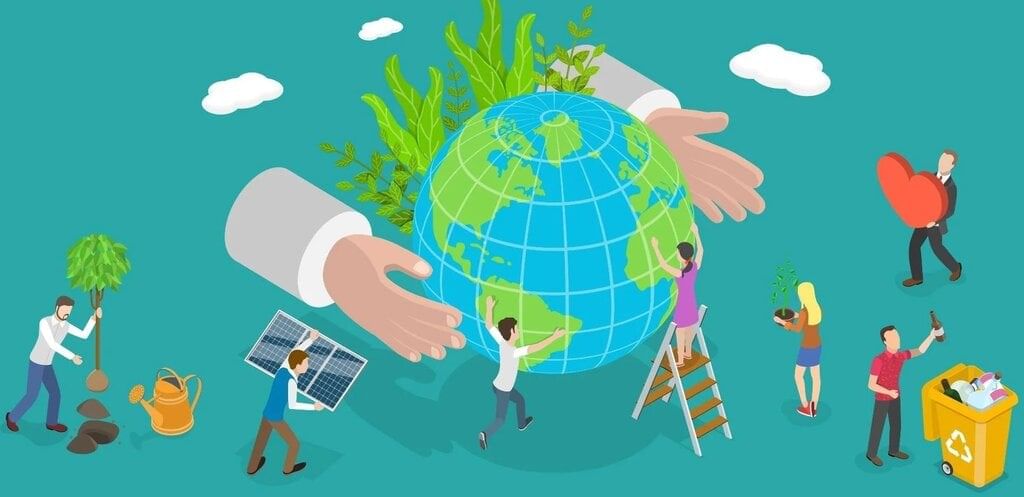Class 1 Exam > Class 1 Notes > General Knowledge for Young Learners > Conservation and Sustainable Living – Afforestation, recycling, saving resources
Conservation and Sustainable Living – Afforestation, recycling, saving resources | General Knowledge for Young Learners - Class 1 PDF Download
| Table of contents |

|
| Conservation and Sustainable Living |

|
| Introduction to Conservation |

|
| Afforestation |

|
| Recycling |

|
| Saving Resources |

|
| Sustainable Living |

|
| Role of Students |

|
Conservation and Sustainable Living
(Afforestation, Recycling, Saving Resources)Conservation and sustainable living are about using our natural resources wisely so that they are available for future generations. This topic teaches us how to protect our environment and create a balance between human needs and nature.

Introduction to Conservation
- Conservation means protecting and wisely using natural resources like water, soil, forests, and energy.
- It helps maintain the balance of nature and ensures resources do not run out.
- Examples of conservation include planting trees, saving electricity, reducing waste, and protecting wildlife.
Afforestation
Afforestation is the process of planting trees in an area where there were no previous trees.Why Afforestation is Important
- Prevents Soil Erosion – Tree roots hold the soil together.
- Reduces Global Warming – Trees absorb carbon dioxide and release oxygen.
- Maintains Rainfall – Forests attract rain and keep the water cycle in balance.
- Provides Habitats – Many animals and birds depend on forests for shelter.
- Improves Air Quality – Trees act as natural air filters.
Examples
- Government initiatives like Van Mahotsav in India encourage tree planting.
- Urban tree plantation drives in cities to reduce pollution.
Recycling
Recycling means reusing waste materials to make new products.Benefits of Recycling
- Reduces Waste – Less garbage goes into landfills.
- Saves Energy – Recycling uses less energy than making products from raw materials.
- Conserves Natural Resources – Paper recycling saves trees; metal recycling saves mining resources.
- Reduces Pollution – Fewer toxins are released into the environment.
Examples of Recycling
- Paper Recycling – Old notebooks made into new paper.
- Plastic Recycling – Used plastic bottles turned into new containers or fabric.
- E-Waste Recycling – Old phones, computers, and batteries are collected and reused safely.
Saving Resources
We should use natural resources wisely to prevent them from running out.Ways to Save Resources
- Water – Turn off taps while brushing, use rainwater harvesting.
- Electricity – Switch off lights/fans when not in use, use LED bulbs.
- Fuel – Carpool, use public transport, cycle for short distances.
- Food – Avoid wasting food, compost leftovers to make manure.
Importance
- Saves money.
- Reduces pressure on nature.
- Creates a healthy environment for future generations.
Sustainable Living
Sustainable living means living in harmony with nature and making choices that do not harm the planet.Principles of Sustainable Living
- Reduce, Reuse, Recycle – Minimize waste.
- Use Renewable Energy – Solar, wind, and hydropower.
- Eco-Friendly Products – Use cloth bags instead of plastic.
- Plant More Trees – Support afforestation programs.
Role of Students
Students can play an important role in promoting conservation:- Join eco-clubs and participate in tree plantation drives.
- Spread awareness about recycling and saving resources.
- Practice sustainable habits at home and school.
Conclusion
Conservation and sustainable living are the key to a healthy future. By planting trees, recycling, and saving resources, we can make the Earth greener and safer for everyone. Every small action counts!
The document Conservation and Sustainable Living – Afforestation, recycling, saving resources | General Knowledge for Young Learners - Class 1 is a part of the Class 1 Course General Knowledge for Young Learners.
All you need of Class 1 at this link: Class 1
|
64 videos|153 docs|40 tests
|
FAQs on Conservation and Sustainable Living – Afforestation, recycling, saving resources - General Knowledge for Young Learners - Class 1
| 1. What is conservation and why is it important? |  |
Ans. Conservation refers to the responsible management of natural resources to prevent depletion and ensure sustainability for future generations. It is important because it helps protect biodiversity, maintains ecological balance, and ensures that resources such as water, soil, and forests are available for future use.
| 2. What is afforestation and how does it benefit the environment? |  |
Ans. Afforestation is the process of planting trees in an area where there were none before. It benefits the environment by increasing carbon sequestration, improving air quality, preventing soil erosion, and providing habitats for wildlife. Additionally, it can help combat climate change by reducing atmospheric carbon dioxide levels.
| 3. How does recycling contribute to sustainable living? |  |
Ans. Recycling contributes to sustainable living by reducing the amount of waste sent to landfills, conserving natural resources, and saving energy. By recycling materials like paper, glass, and metals, we can reduce the need for new raw materials, thus minimizing environmental degradation and promoting a circular economy.
| 4. What are some practical ways to save resources in daily life? |  |
Ans. Practical ways to save resources in daily life include turning off lights when not in use, using water-saving fixtures, reducing single-use plastics, and opting for public transportation or carpooling. Additionally, buying in bulk and choosing energy-efficient appliances can significantly lower resource consumption.
| 5. What role can students play in promoting conservation and sustainable living? |  |
Ans. Students can play a crucial role in promoting conservation and sustainable living by participating in awareness campaigns, organizing clean-up drives, and practicing sustainable habits in their daily lives. They can also advocate for environmental policies and engage in community service projects that focus on conservation efforts.
|
64 videos|153 docs|40 tests
|
Download as PDF
Related Searches


















